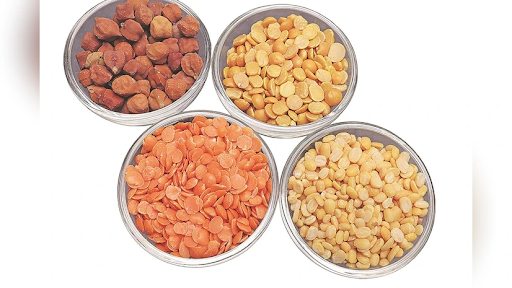





Copyright infringement not intended
Picture Courtesy: https://www.downtoearth.org.in/governance/nutrition-investments-in-agri-food-sector-can-reduce-gender-inequalities-report
Context: The Global Alliance for Improved Nutrition (GAIN) released a report, "The Case for Investment in Nutritious Foods Value Chains," highlighting the need for more funding in nutritious food value chains.
Details
|
Global Alliance for Improved Nutrition (GAIN) ●It is a non-profit foundation that was developed during the United Nations (UN) 2002 Special Session of the General Assembly on Children. ●Their activities focus on improving the consumption of nutritious and safe foods for all, with a 20-year history of food system programs targeting adolescent and child nutrition, food system research, fortification, small and medium enterprise assistance, biofortification of crops, and reducing post-harvest losses. ●The headquarters are in Geneva, Switzerland, as well as offices in countries with high levels of malnutrition such as Bangladesh, Ethiopia, India, Indonesia, Kenya, Mozambique, Nigeria, Pakistan, and Tanzania. ●The Nutrition Enterprise Unit at GAIN supports and represents over 1000 small and medium enterprises globally across the food system. They provide technical assistance, debt investments, and support to SMEs across Sub-Saharan Africa. ●GAIN's efforts include addressing social and contextual changes within food systems, such as gender, environmental issues, technology, and social norms. ●Their programs focus on generating consumer demand for healthy diets, making social protection programs more nutrition-sensitive, and enhancing food systems resilience. |
The Gender Divide in Agri-Food Sectors
Significance of Nutrition Investments
Investing in nutritious food value chains can address these issues in several ways:
Geography-Specific Opportunities
The report identifies six nutritious food value chains in three regions where investments could make a significant impact:
Gender-Lens Investing
The report highlights the importance of the ‘2X criteria,’ updated in June 2024. This framework helps investors:
|
Investments in nutritious food value chains not only support better nutrition and food security but also offer significant opportunities to reduce gender disparities. By focusing on these investments, businesses can enhance productivity, support women’s empowerment, and contribute to broader economic growth. |
Nutrition Investments in the Agri-Food Sector
Investing in nutrition is crucial because it:
Key Areas of Investment
|
Agricultural Production |
●Crop Diversification: Investing in a variety of crops to ensure a range of nutrients and reduce dependency on a single crop. This helps improve food security and nutritional intake. ●Biofortification: Enhancing the nutrient content of crops through breeding or genetic modification. For example, fortifying crops with vitamins and minerals to address deficiencies in the population. ●Sustainable Farming Practices: Encouraging methods that preserve the environment, such as reduced use of chemicals, conservation tillage, and organic farming. This helps maintain soil health and reduces the ecological footprint. |
|
Food Processing
|
●Fortification: Adding essential vitamins and minerals to processed foods. For instance, adding iodine to salt or iron to flour to prevent deficiencies. ●Reduction of Post-Harvest Losses: Improving storage and processing methods to reduce the amount of food that spoils or is wasted before reaching consumers. This ensures that more nutritious food is available. ●Value Addition: Enhancing the quality and shelf life of food products through processing. This includes creating products like fortified cereals or nutrient-rich snacks. |
|
Distribution and Supply Chain
|
●Cold Chain Infrastructure: Developing refrigeration and transportation systems to keep perishable foods fresh. This helps maintain the nutritional value of foods from farm to table. ●Efficient Logistics: Streamlining transportation and storage to minimize delays and losses. Efficient logistics ensure that food reaches consumers in a timely manner. ●Market Access: Expanding access to markets for farmers and food producers. This includes creating better distribution channels and reducing barriers to market entry. |
|
Consumer Access and Education
|
●Nutrition Education Programs: Educating the public about healthy eating habits and the benefits of consuming a balanced diet. This can be done through schools, community programs, and media campaigns. ●Food Safety Standards: Implementing and enforcing standards to ensure that food is safe to eat and free from contaminants. This protects consumer health and enhances confidence in the food supply. |
|
Subsidies and Incentives |
●Subsidies: Providing financial support to encourage the production of nutritious foods or the adoption of healthy farming practices. This can lower costs for farmers and make nutritious foods more affordable for consumers. ●Incentives: Offering rewards or benefits to businesses and individuals who contribute to improving food nutrition. This might include tax breaks for companies that produce fortified foods or grants for research on nutritional improvements. |
Stakeholders Involved
Government
Private Sector
Non-Governmental Organizations (NGOs)
Challenges and Barriers
Economic
Social
Environmental
Technological
Impact Assessment
Health Outcomes
Economic Benefits
Environmental Sustainability
Way Forward
Conclusion
Must Read Articles:
DIETARY GUIDELINES FOR INDIA 2024
DIETARY HABITS AND NUTRITIONAL CHALLENGES IN INDIA
Source:
|
PRACTICE QUESTION Q. How can nutrition investments in the agri-food sector be integrated with climate change adaptation and mitigation strategies to build resilient food systems that can deliver nutritious food under changing climatic conditions? |






© 2025 iasgyan. All right reserved